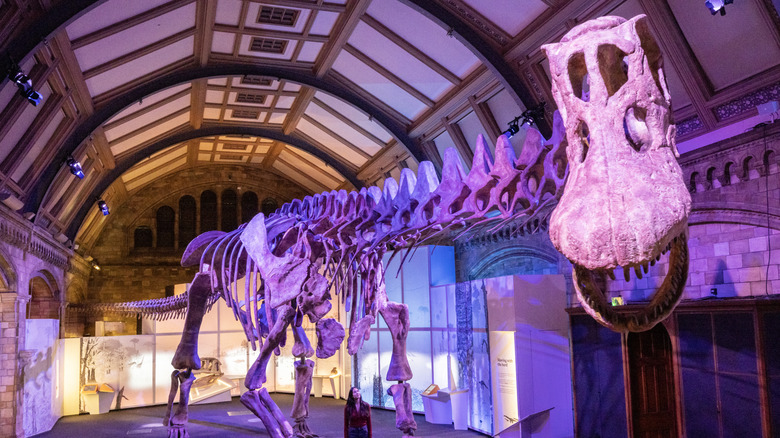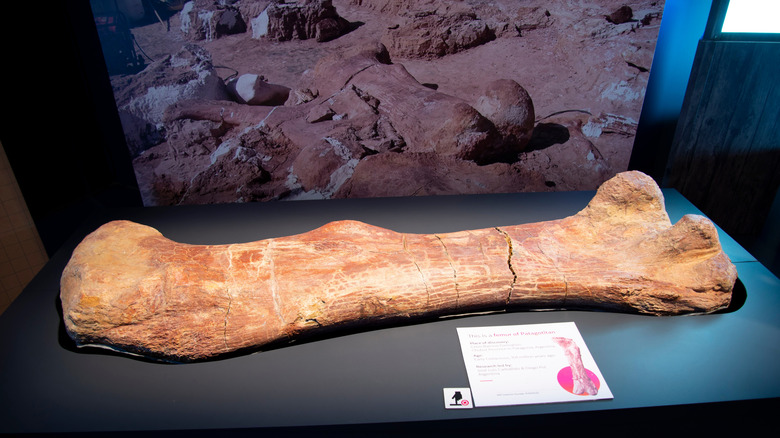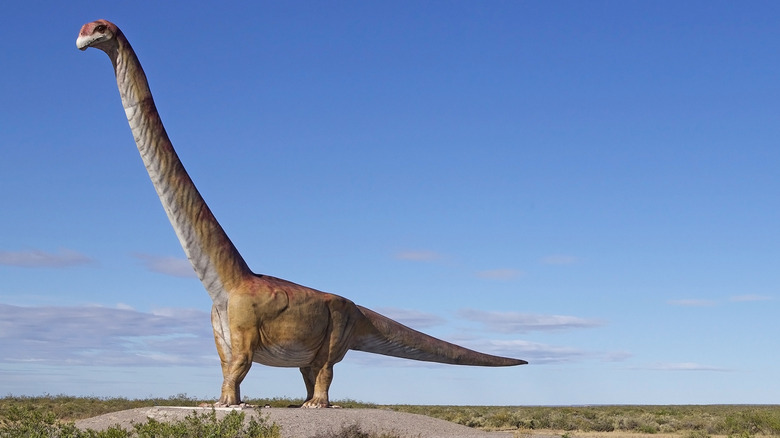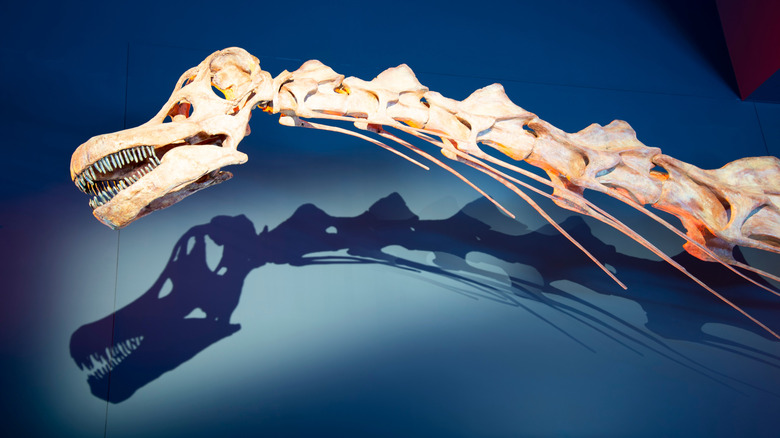The Largest Dinosaur Ever Discovered Totally Dwarfs Our Largest Land Animals Today
Dinosaurs come in all shapes and sizes, and although the smallest dinosaur species were certainly notable in their own right, it is the largest of these creatures that have really elicited terror and wonder amongst us. And given that the average non-avian dinosaur was comparable in size to a rhinoceros or elephant, most dinosaurs fell into the "large" category.
Elephants, specifically African elephants, are the largest land animals alive today. Adult males typically weigh between 4,000 and 14,000 pounds. That's about 30–100 average adult humans. It's hard to imagine anything bigger, but there was once a dinosaur that was 12 times as massive as an average African elephant, and over 1,000 times heavier than the average person.
Patagotitan mayorum is the largest dinosaur species ever discovered, and the biggest land animal ever known to have existed. It may have weighed close to 70 tons, or 140,000 pounds, and likely reached lengths over 120 feet. That would make it longer than the blue whale, which is not only the largest whale species, but also the biggest animal to ever exist. Although longer, Patagotitan doesn't unseat the blue whale because it only weighed half as much, but still, the largest land animal ever is a remarkable record to hold. There's a lot we have yet to learn about Patagotitan though, and that's because it's not just the biggest dinosaur, but also one of the most recent to be discovered.
The improbable discovery of Patagotitan
The discovery of Patagotitan was a happy accident that nobody could have seen coming. It all began on La Flecha ranch in the Patagonia region of Argentina. One day in 2010, a ranch worker named Aurelio Hernandez saw something strange on the property: part of a massive femur bone poking out of the ground. He notified the owner of the ranch, Oscar Mayo, who realized they had stumbled across something special and contacted paleontologists from the Egidio Feruglio Paleontological Museum in the nearby city of Trelew to investigate.
Excavations were carried out at the ranch in 2012, 2013, and 2015. All told, the paleontology team unearthed over 200 fossils, determining that they belonged to at least six different individuals. The fossils were spread throughout three different layers of sediment, indicating that the six in question did not die all at once, but rather at three distinct periods. What caused their deaths is a mystery. One theory proposes that the site used to have a lake, which the dinosaurs would frequent, but which gradually dried up, causing them to die of thirst. Another theory proposes that it was actually excess water, in the form of three floods, that buried them.
In 2017, the newly-discovered dinosaur finally got its official name: Patagotitan mayorum. The "Patago" portion refers to the Patagonia region where the fossils were found, while "titan" pulls from the Titans of Greek mythology. The species name, "mayorum" honors the Mayo family, owners of La Flecha ranch.
The life of a Patagotitan
The fossils of Patagotitan uncovered in Argentina were dated back to 101 million years ago. That timeline places these beasts in the Cretaceous period, which was the last of the three time periods in which the dinosaurs ruled the planet. They lived in fertile plains and river valleys with rich vegetation for them to feed on. Their blunt teeth were specialized for the purpose of stripping leaves from trees and swallowing them whole. With such massive bodies, Patagotitans would have needed to eat over 250 pounds of vegetation every day, and their long necks would have been crucial in helping them access every available food source from the ground to the highest treetops. As they ate, they also spread seeds through their poop, a vital step to maintaining biodiversity, and one that is also performed by elephants today.
Sauropods (long-necked dinosaurs) are thought to have acquired their great size to help them get the most out of their food. The vegetation they fed on was not easy to digest, so they needed exceptionally long digestive tracts to extract every possible nutrient. It would have taken around 10 days for a Patagotitan's meal to make it from one end to the other. One thing that has scientists baffled, however, is why Patagotitan grew even bigger than other sauropod species like the brontosaurus and diplodocus. There might have been something unique to the dinosaur's environment that made it a record-holder, but thus far, researchers haven't found a clue.
Why there's some controversy over Patagotitan's size
Patagotitan belongs to a group of sauropods known as Titanosauria, or titanosaurs. Not only were titanosaurs much larger than other sauropods, they also survived later than their smaller long-necked counterparts, all the way until the asteroid strike that ultimately caused the extinction of all non-avian dinosaurs. There are over 100 known titanosaur species, making it the most diverse clade of sauropods. However, most titanosaurs, like Patagotitan, are fairly recent discoveries, leaving countless questions about them, including how realistic their size estimates are.
Attempts to determine the exact size of extinct animals inherently involve guesswork. After all, it's impossible to firmly say how much an animal weighed when all of its organs and musculature have vanished. There is even some doubt over exactly how long Patagotitan was, because none of the fossils uncovered was a complete skeleton. Full-scale models in museums, such as Máximo, a Patagotitan displayed at Chicago's Field Museum, are made by scientists taking the fossils they do have and filling in the blank spots with educated guesses.
A 2020 study published in the Journal of Vertebrate Paleontology concluded that, although some Patagotitans likely reached 70 tons, 57 tons was a more likely average. Amidst all this uncertainty, there is another dinosaur challenging Patagotitan for the size record. It's another titanosaur called Argentinosaurus, but there's a problem. Hardly any fossils from Argentinosaurus have been found, meaning that, for the time being, Patagotitan holds the crown of the largest land animal in history.



